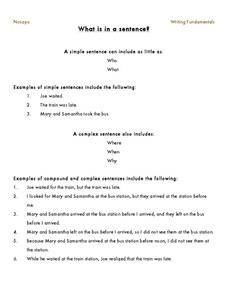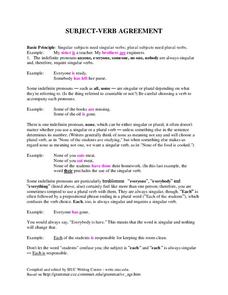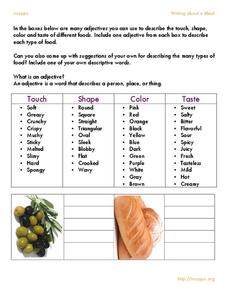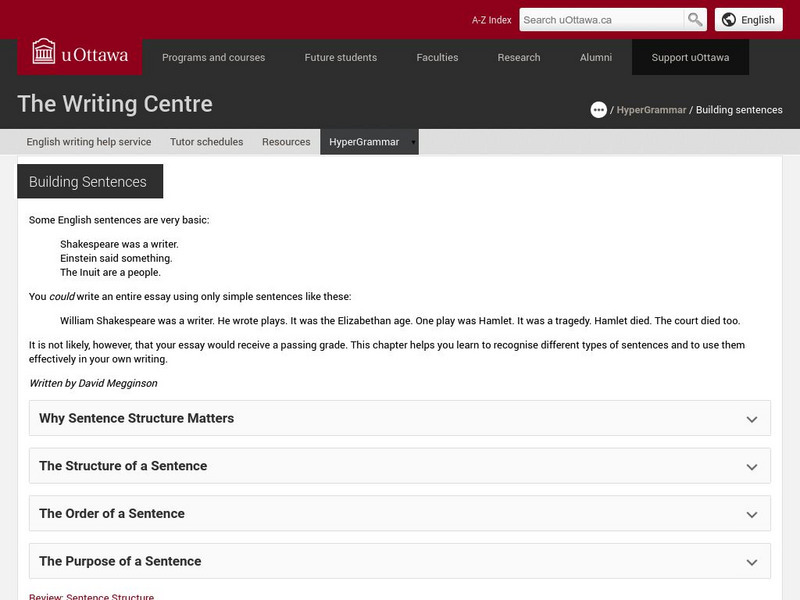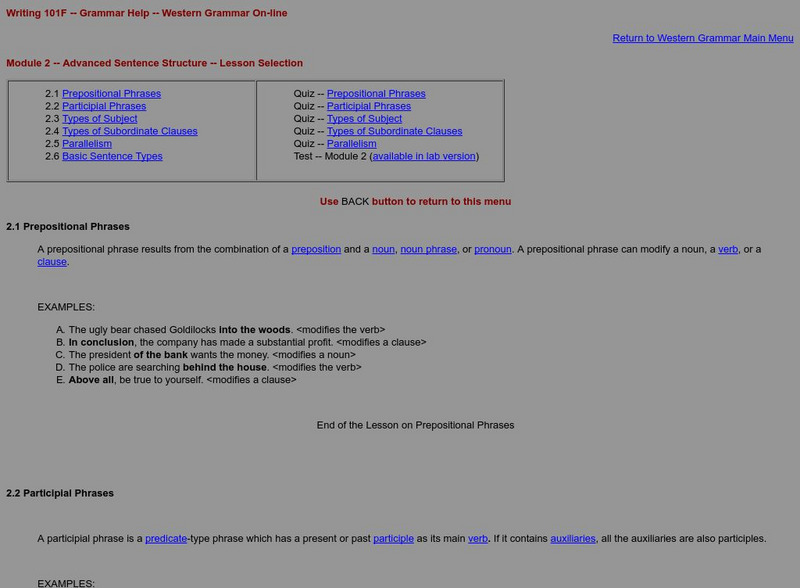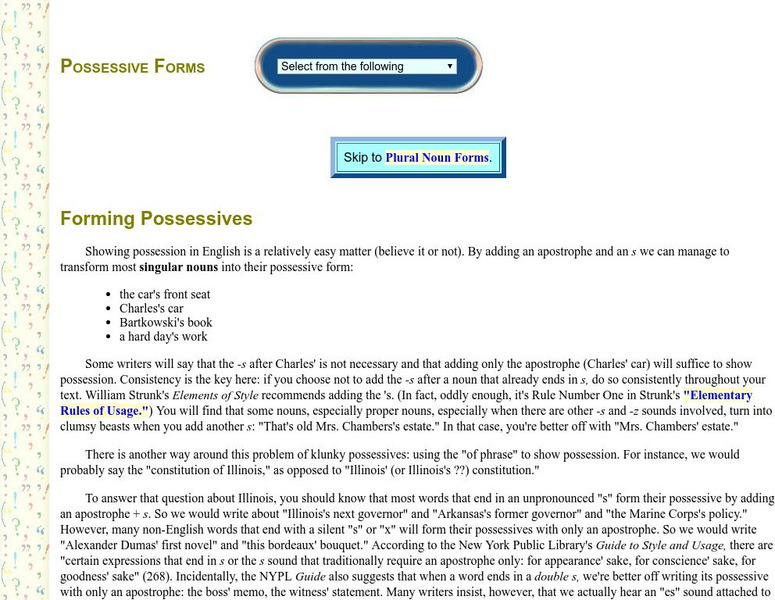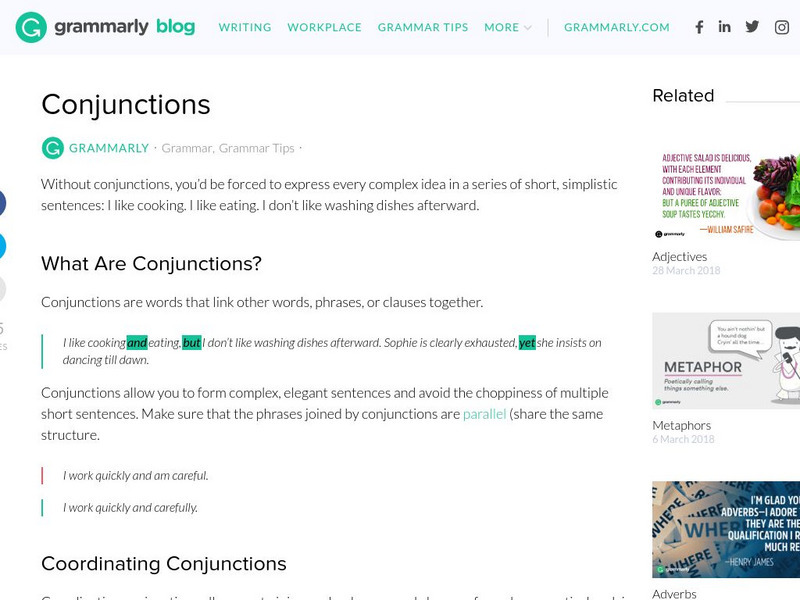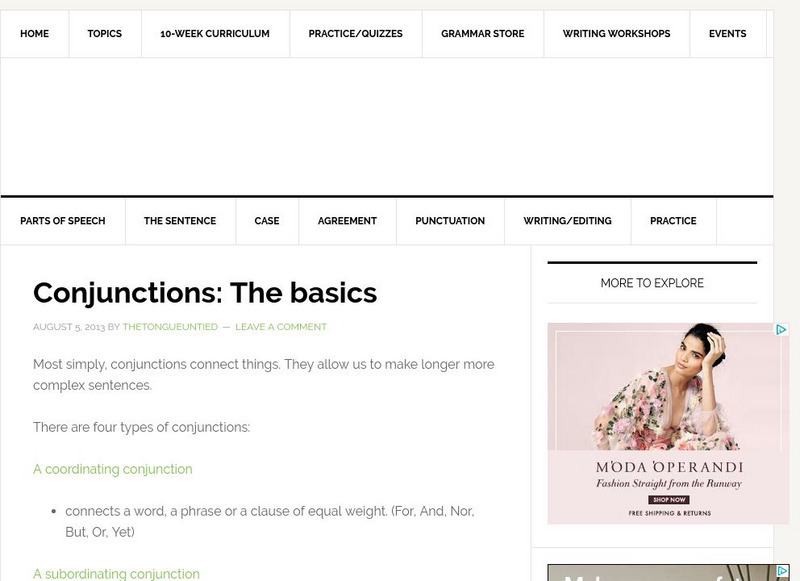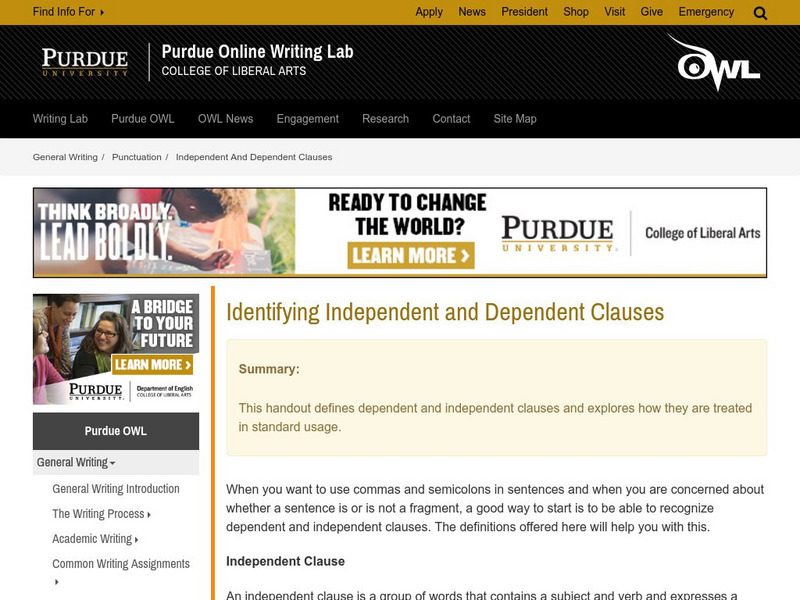Nosapo
What Is in a Sentence, Paragraph, and Story?
Language arts is made up of many parts. Learners review the parts of a sentence, as well as how to make a simple sentence into a complex sentence, before examining full paragraphs and identifying the topic, body, and concluding sentence...
Jolly Learning Ltd
Jolly Grammar Action Chart
An excellent grammar reference page from Jolly Phonics provides definitions and actions to remember several fundamental parts of speech. The methods are interesting for learners who have a hard time remembering the differences between...
Southern Illinois University
Subject-Verb Agreement
Your writing lessons may be all about solid arguments, but in grammar, it's all about agreement! Learners practice identifying proper and improper verb form in a worksheet focused on subject-verb agreement and indefinite pronouns.
Nosapo
Writing about a Meal
You don't need to be a food critic to describe your meal accurately! A series of activities introduce learners to vivid adjectives when writing about the taste, smell, and feel of food. After working with word choice, parts of a...
Liberty High School
Science Department Lab Report Format
Make sure your scientists are reporting their work effectively by providing them with a reference for their lab reports. The first few pages of this resource detail each element of a lab report, and the last few pages provide an example...
University of Ottawa (Canada)
University of Ottawa: Hyper Grammar: Building Sentences
An excellent site which outlines the types of sentences - simple, compound, and complex. Gives in-depth information and examples of each. Includes review exercises for practice or assessment.
Capital Community College Foundation
Guide to Grammar and Writing: Principles of Composition
If you are a teacher OR a student looking for a well-informed website on elements of the writing process, you are in luck! This site from the Capital Community College is very comprehensive and easy-to-navigate. From grammar basics to...
TES Global
Tes: Sentences: Simple, Compound and Complex
[Free Registration/Login Required] This downloadable reference provides notes and examples of different types of sentences. Simple sentences, compound sentences, and complex sentences are discussed on the resource pages.
University of Washington
Mary Nell's Grammar Summaries
The University of Washington provides an excellent collection of grammar-related summaries. The collection includes material on verb tenses, agreement, noncount nouns, and many other topics.
Capital Community College Foundation
Guide to Grammar and Writing: Clauses: The Essential Building Blocks
Online PowerPoint writing tutorial on the subject of clauses in sentences. L.9-10.1b Phrases/Clauses
Other
Western Grammar: Module 2: Advanced Sentence Structure
Online grammar textbook explaining sentence structure provides definitions of different types of subordinate clauses and exercises related to this topic. There is also information on phrases and other components of sentences.
Capital Community College Foundation
Guide to Grammar and Writing: Possessive Forms
As you learn possessive forms, you will also learn about gerunds, present participles, compound nouns and more. This is a very complete resource tool for this subject.
Grammarly
Grammarly Blog: Conjunctions
This page focuses on conjunctions including what conjunctions are; the types of conjunctions: Coordinating, Correlative, and Subordinating; how to start sentences with conjunctions, examples of each of the above, and lists for each type...
Grammarly
Grammarly Blog: Concrete Nouns
This Grammarly Handbook resource provides a definition for concrete nouns. Examples of concrete nouns in the context of sentences are provided.
University of Victoria (Canada)
The U Vic Writer's Guide: Grammar: Clauses
This site discusses the two main types of clauses. Content includes instructions for and examples of using clauses to build different types of sentences and information on recognizing types of clauses.
Robin L. Simmons
Grammar Bytes: The Demonstrative Pronoun
Printable information is provided that demonstrates how to identify a demonstrative pronoun in the context of a sentence.
Robin L. Simmons
Grammar Bytes: The Intransitive Verb
Printable information is provided that demonstrates how to identify an intransitive verb in the context of a sentence.
The Write Place
Literacy Education Online
Literacy Education Online (or LEO) is a great place to start if you need help with your writing. The homepage is organized around kinds of problems or questions you might have concerning your writing. Find your problem, click on the...
Capital Community College Foundation
Guide to Grammar and Writing: Abstract Nouns
The composition of a noun is more than just a person, place or thing. Use this resource to study examples of nouns and their many uses.
Online Writing Lab at Purdue University
Purdue University Owl: General Writing Resources
This helpful resource details the process of writing, including how to plan, write, and revise. Content also includes the different types or genres of writing, and exercises in grammar and mechanics.
Other
Literacy for the 21st Century: Six Types of Context Clues [Pdf]
This is a chart that explains the six types of context clues with descriptions and sample sentences. It includes definition, example/illustration, grammar, logic, contrast, and word roots and affixes.
Capital Community College Foundation
Guide to Grammar and Writing: Abbreviations
A very competent look at how to use abbreviations in their proper context. This site also examines the proper use of abbreviations with titles, numbers and phrases.
The Tongue Untied
The Tongue Untied: Conjunctions
Come and learn about all types of conjunctions when you visit this educational resource. This site gives a clear definition of the function of a conjunction. Use the "Turn the Page," function to learn more.
Online Writing Lab at Purdue University
Purdue University Owl: Independent and Dependent Clauses
This online writing lab offers definitions of the two main types of clauses as well as related concepts. It provides examples and offers instructions for avoiding common mistakes with clauses. L.9-10.1b Phrases/Clauses
